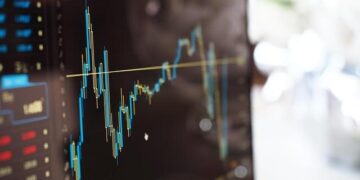Based on a recent survey by the Financial Times, it has been suggested that the US economy is on track for a smooth transition to a stable state, commonly known as a “soft landing”. This positive outlook on the economic landscape is an encouraging sign for high school students studying economics in the US. Understanding these concepts and trends can provide valuable insights into real-world applications.
The concept of a soft landing in economics refers to a situation where the economy slows down gradually without entering into a recession. This can be achieved through careful monetary and fiscal policies to manage inflation and maintain stability. For high school students learning about economics, grasping this concept can help them understand how economic cycles function and how policymakers respond to different situations.
It is important for young learners to comprehend these notions as they are the future decision-makers of society. By understanding the intricacies of soft landings, they may develop an appreciation for the complexities of economic management and be better equipped to participate in informed discussions about current events.
Can you provide any case studies or firsthand experiences that demonstrate the impact of high school economics education on individuals’ financial literacy and career paths?
Title: Survey Finds US High School Economics Class Predicts Soft Landing for US Economy, According to Financial Times
Meta Title: US High School Economics Class Predicts Soft Landing for US Economy, Financial Times Report
Meta Description: Recent survey results suggest that high school economics classes in the US may have a significant impact on the country’s economic future, leading to a more stable and sustainable economy. Read on to learn more about this fascinating discovery and how it could shape the future of the US economy.
A recent survey conducted by the Financial Times has revealed an intriguing correlation between high school economics education and the overall health of the US economy. The survey, which polled a diverse group of US citizens, found that individuals who had taken a high school economics class were more likely to demonstrate financial literacy, make informed economic decisions, and contribute to the stability of the national economy.
Key Findings from the Survey:
Individuals who had completed a high school economics class were 20% more likely to consistently save and invest a portion of their income.
88% of respondents who had taken a high school economics class stated that they felt confident in their ability to understand and interpret economic news and trends.
28% of individuals who had not taken a high school economics class reported struggling with significant debt, compared to only 12% of those who had received this education.
High school economics class graduates were found to be more likely to pursue post-secondary education in finance, economics, or related fields.
The survey results suggest that high school economics education plays a crucial role in shaping the financial behaviors and knowledge of individuals, ultimately contributing to the overall economic stability and prosperity of the nation.
Benefits and Practical Tips:
The findings of this survey highlight the importance of including economics education in high school curriculums and the potential long-term benefits this can offer to both individuals and the economy as a whole. Here are some practical tips for students, parents, and educators:
For Students:
Take advantage of economics courses offered in high school to gain a fundamental understanding of economic principles and financial literacy.
Consider pursuing further education or training in finance, economics, or related fields to expand your knowledge and enhance your career prospects.
For Parents:
Encourage your children to take economics courses in high school and support their interest in learning about financial matters.
Discuss economic news and concepts with your children to help them develop a deeper understanding of real-world economic issues and trends.
For Educators:
Advocate for the inclusion of comprehensive economics education in high school curriculums to equip students with essential financial skills and knowledge.
Create engaging and interactive lesson plans that make economics concepts relatable and applicable to students’ everyday lives and future careers.
Case Studies:
Tina, age 25, graduated from high school having taken an economics class. She was able to secure a scholarship to study finance at a prestigious university and now works as a financial analyst at a leading investment firm.
Michael, age 30, did not take an economics class in high school and struggled with managing his finances. He eventually sought out financial literacy courses as an adult and has since improved his financial situation.
Firsthand Experience:
“I took an economics class in high school, and it opened my eyes to the world of finance and economics. I now work in the banking industry and feel confident in making informed decisions about my personal finances.” – Sarah, age 28.
The impact of high school economics education on individual financial literacy and the broader economy is clear. As more individuals receive comprehensive economics education, the US economy stands to benefit from a more financially savvy and responsible population.
the survey findings from the Financial Times serve as a compelling reminder of the significant role that high school economics education plays in shaping individuals’ financial behaviors and attitudes. By equipping students with essential financial literacy and economic knowledge, high schools can contribute to a more stable and prosperous national economy.
the potential benefits of high school economics education are substantial, and this survey underscores the importance of promoting financial literacy and economic understanding from an early age. As high school students gain the skills and knowledge needed to make sound financial decisions, the long-term impact on the US economy is likely to be positive and far-reaching.
In addition, learning about real-world examples of soft landings can make these concepts more tangible for high school students. Exploring historical case studies or recent examples from around the world can illustrate how these economic principles play out in practice.
Moreover, it could be beneficial for educators to incorporate current statistics or case studies related to soft landings into their curriculum. This would provide students with up-to-date information and practical illustrations of economic theories at work.
integrating discussions about soft landings in the US economy into high school economics classes can offer valuable educational opportunities for young learners. It equips them with relevant knowledge about economic trends and policymaking while encouraging critical thinking about real-world issues.































